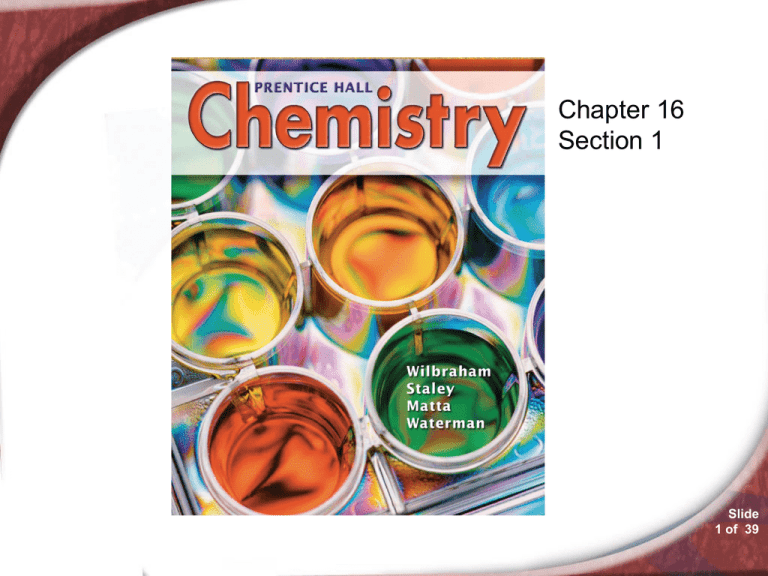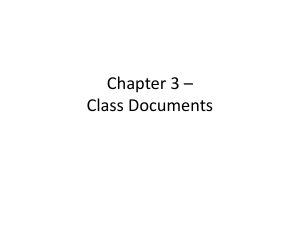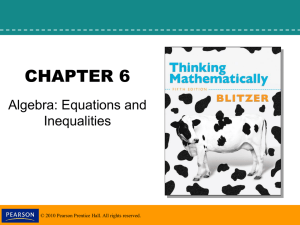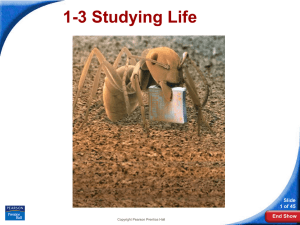
Chemistry 16.1
Chapter 16
Section 1
Slide
1 of 39
16.1
Properties of Solutions
A sinkhole forms when the roof
of a cave weakens from being
dissolved by groundwater and
suddenly collapses. One
recorded sinkhole swallowed a
house, several other buildings,
five cars, and a swimming pool!
You will learn how the solution
process occurs and the factors
that influence the process.
© Copyright Pearson Prentice Hall
Slide
2 of 39
16.1
Properties of Solutions > Solution Formation
Solution Formation
What factors determine the rate at
which a substance dissolves?
Slide
3 of 39
© Copyright Pearson Prentice Hall
16.1
Properties of Solutions > Solution Formation
The compositions of the solvent and the
solute determine whether a substance
will dissolve. The factors that determine
how fast a substance dissolves are
• stirring (agitation)
• temperature
• the surface area of the dissolving
particles
Slide
4 of 39
© Copyright Pearson Prentice Hall
16.1
Properties of Solutions > Solution Formation
A cube of sugar in cold tea dissolves slowly.
Slide
5 of 39
© Copyright Pearson Prentice Hall
16.1
Properties of Solutions > Solution Formation
Granulated sugar dissolves in cold water more
quickly than a sugar cube, especially with
stirring.
Slide
6 of 39
© Copyright Pearson Prentice Hall
16.1
Properties of Solutions > Solution Formation
Granulated sugar dissolves very quickly in hot
tea.
Slide
7 of 39
© Copyright Pearson Prentice Hall
16.1
Properties of Solutions > Solution Formation
Stirring and Solution Formation
Stirring speeds up the dissolving process
because fresh solvent (the water in tea) is
continually brought into contact with the surface
of the solute (sugar).
Slide
8 of 39
© Copyright Pearson Prentice Hall
16.1
Properties of Solutions > Solution Formation
Temperature and Solution Formation
At higher temperatures, the kinetic energy of
water molecules is greater than at lower
temperatures, so they move faster. As a result,
the solvent molecules collide with the surface of
the sugar crystals more frequently and with more
force.
Slide
9 of 39
© Copyright Pearson Prentice Hall
16.1
Properties of Solutions > Solution Formation
Particle Size and Solution Formation
A spoonful of granulated sugar dissolves more
quickly than a sugar cube because the smaller
particles in granulated sugar expose a much
greater surface area to the colliding water
molecules.
Slide
10 of 39
© Copyright Pearson Prentice Hall
16.1
Properties of Solutions > Solubility
Solubility
How is solubility usually expressed?
Slide
11 of 39
© Copyright Pearson Prentice Hall
16.1
Properties of Solutions > Solubility
A saturated solution contains the maximum
amount of solute for a given quantity of solvent at
a given temperature and pressure.
An unsaturated solution contains less solute
than a saturated solution at a given temperature
and pressure.
Slide
12 of 39
© Copyright Pearson Prentice Hall
16.1
Properties of Solutions > Solubility
In a saturated solution,
the rate of dissolving
equals the rate of
crystallization, so the
total amount of dissolved
solute remains constant.
Slide
13 of 39
© Copyright Pearson Prentice Hall
16.1
Properties of Solutions > Solubility
The solubility of a substance is the
amount of solute that dissolves in a given
quantity of a solvent at a specified
temperature and pressure to produce a
saturated solution.
Solubility is often expressed in grams
of solute per 100 g of solvent.
Slide
14 of 39
© Copyright Pearson Prentice Hall
16.1
Properties of Solutions > Solubility
Some liquids combine in all proportions, while
others don’t mix at all.
• Two liquids are miscible if they dissolve in
each other in all proportions.
• Two liquids are immiscible if they are
insoluble in each other.
Slide
15 of 39
© Copyright Pearson Prentice Hall
16.1
Properties of Solutions > Solubility
Oil and water are immiscible.
Slide
16 of 39
© Copyright Pearson Prentice Hall
16.1
Properties of Solutions > Solubility
Vinegar and oil are immiscible.
Slide
17 of 39
© Copyright Pearson Prentice Hall
16.1
Properties of Solutions > Factors Affecting Solubility
Factors Affecting Solubility
What conditions determine the amount
of solute that will dissolve in a given
solvent?
Slide
18 of 39
© Copyright Pearson Prentice Hall
16.1
Properties of Solutions > Factors Affecting Solubility
Temperature affects the solubility of
solid, liquid, and gaseous solutes in a
solvent; both temperature and pressure
affect the solubility of gaseous solutes.
Slide
19 of 39
© Copyright Pearson Prentice Hall
16.1
Properties of Solutions > Factors Affecting Solubility
Temperature
• The solubility of most solid substances
increases as the temperature of the solvent
increases.
• The solubilities of most gases are greater in
cold water than in hot.
Slide
20 of 39
© Copyright Pearson Prentice Hall
16.1
Properties of Solutions > Factors Affecting Solubility
The mineral deposits
around hot springs
result from the cooling
of the hot, saturated
solution of minerals
emerging from the
spring.
Slide
21 of 39
© Copyright Pearson Prentice Hall
16.1
Properties of Solutions > Factors Affecting Solubility
Slide
22 of 39
© Copyright Pearson Prentice Hall
16.1
Properties of Solutions > Factors Affecting Solubility
A supersaturated solution contains more
solute than it can theoretically hold at a given
temperature.
The crystallization of a supersaturated solution
can be initiated if a very small crystal, called a
seed crystal, of the solute is added.
Slide
23 of 39
© Copyright Pearson Prentice Hall
16.1
Properties of Solutions > Factors Affecting Solubility
A supersaturated solution is clear before a seed
crystal is added.
Slide
24 of 39
© Copyright Pearson Prentice Hall
16.1
Properties of Solutions > Factors Affecting Solubility
Crystals begin to form in the solution
immediately after the addition of a seed crystal.
Slide
25 of 39
© Copyright Pearson Prentice Hall
16.1
Properties of Solutions > Factors Affecting Solubility
Excess solute crystallizes rapidly.
Slide
26 of 39
© Copyright Pearson Prentice Hall
Properties of Solutions > Factors Affecting Solubility
Simulation 20
Observe the effect of temperature on the
solubility of solids and gases in water.
Slide
27 of 39
© Copyright Pearson Prentice Hall
16.1
Properties of Solutions > Factors Affecting Solubility
Slide
28 of 39
© Copyright Pearson Prentice Hall
16.1
Properties of Solutions > Factors Affecting Solubility
Pressure
Changes in pressure have little effect on the
solubility of solids and liquids, but pressure
strongly influences the solubility of gases.
Gas solubility increases as the partial pressure
of the gas above the solution increases.
Slide
29 of 39
© Copyright Pearson Prentice Hall
16.1
Properties of Solutions > Factors Affecting Solubility
Henry’s law states that at a given temperature,
the solubility (S) of a gas in a liquid is directly
proportional to the pressure (P) of the gas above
the liquid.
Slide
30 of 39
© Copyright Pearson Prentice Hall
SAMPLE PROBLEM 16.1
Slide
31 of 39
© Copyright Pearson Prentice Hall
SAMPLE PROBLEM 16.1
Slide
32 of 39
© Copyright Pearson Prentice Hall
SAMPLE PROBLEM 16.1
Slide
33 of 39
© Copyright Pearson Prentice Hall
SAMPLE PROBLEM 16.1
Slide
34 of 39
© Copyright Pearson Prentice Hall
Practice Problems for Sample Problem 16.1
Problem Solving 16.2 Solve
Problem 2 with the help of an
interactive guided tutorial.
Slide
35 of 39
© Copyright Pearson Prentice Hall
16.1 Section Quiz.
Assess students’ understanding
of the concepts in Section 16.1.
Continue to:
-or-
Launch:
Section Quiz
Slide
36 of 39
© Copyright Pearson Prentice Hall
16.1 Section Quiz.
1. For a given substance, which of the following
will NOT influence how fast it dissolves?
a. temperature
b. amount of agitation
c. molar mass
d. size of the crystals
Slide
37 of 39
© Copyright Pearson Prentice Hall
16.1 Section Quiz.
2. The solubility of a substance is often
expressed as the number of grams of solute
per
a. 100 liters of solvent.
b. 1 cm3 of solvent.
c. 100 grams of solution.
d. 100 grams of solvent.
Slide
38 of 39
© Copyright Pearson Prentice Hall
16.1 Section Quiz.
3. The solubility of a gas in a solvent is affected
by
a. both temperature and pressure.
b. only pressure.
c. only temperature.
d. both pressure and agitation.
Slide
39 of 39
© Copyright Pearson Prentice Hall
END OF SHOW
Chemistry 16.2
Chapter 16
Section 2
Slide
41 of 46
16.2
Concentrations of Solutions
Water must be tested
continually to ensure that the
concentrations of contaminants
do not exceed established
limits. These contaminants
include metals, pesticides,
bacteria, and even the byproducts of water treatment.
You will learn how solution
concentrations are calculated.
Slide
42 of 46
© Copyright Pearson Prentice Hall
16.2
Concentrations of Solutions > Molarity
Molarity
How do you calculate the molarity of a
solution?
Slide
43 of 46
© Copyright Pearson Prentice Hall
16.2
Concentrations of Solutions > Making Dilutions
She then transfers the 20 mL to a 100-mL
volumetric flask.
Slide
44 of 46
© Copyright Pearson Prentice Hall
16.2
Concentrations of Solutions > Making Dilutions
Finally she carefully adds water to the mark to
make 100 mL of solution.
Slide
45 of 46
© Copyright Pearson Prentice Hall
16.2
Concentrations of Solutions > Making Dilutions
Volume-Measuring Devices
Slide
46 of 46
© Copyright Pearson Prentice Hall
Concentrations16.4
of Solutions >
Slide
47 of 46
© Copyright Pearson Prentice Hall
Concentrations16.4
of Solutions >
Slide
48 of 46
© Copyright Pearson Prentice Hall
Concentrations16.4
of Solutions >
Slide
49 of 46
© Copyright Pearson Prentice Hall
Concentrations16.4
of Solutions >
Slide
50 of 46
© Copyright Pearson Prentice Hall
Concentrations
of Solutions
for Sample Problem
16.4 >
`
Problem Solving 16.12 Solve
Problem 12 with the help of an
interactive guided tutorial.
Slide
51 of 46
© Copyright Pearson Prentice Hall
16.2
Concentrations of Solutions > Percent Solutions
Percent Solutions
What are two ways to express the
percent concentration of a solution?
Slide
52 of 46
© Copyright Pearson Prentice Hall
16.2
Concentrations of Solutions > Percent Solutions
– The concentration of a solution in
percent can be expressed in two
ways: as the ratio of the volume of
the solute to the volume of the
solution or as the ratio of the mass
of the solute to the mass of the
solution.
Slide
53 of 46
© Copyright Pearson Prentice Hall
16.2
Concentrations of Solutions > Percent Solutions
Concentration in Percent
(Volume/Volume)
Slide
54 of 46
© Copyright Pearson Prentice Hall
16.2
Concentrations of Solutions > Percent Solutions
Isopropyl alcohol (2-propanol) is sold as a 91%
solution. This solution consist of 91 mL
of isopropyl alcohol mixed with enough
water to make 100 mL of solution.
Slide
55 of 46
© Copyright Pearson Prentice Hall
Concentrations of Solutions > 16.5
Slide
56 of 46
© Copyright Pearson Prentice Hall
Concentrations of Solutions > 16.5
Slide
57 of 46
© Copyright Pearson Prentice Hall
Concentrations of Solutions > 16.5
Slide
58 of 46
© Copyright Pearson Prentice Hall
Concentrations of Solutions > 16.5
Slide
59 of 46
© Copyright Pearson Prentice Hall
Concentrations of Solutions >
Slide
60 of 46
© Copyright Pearson Prentice Hall
16.2
Concentrations of Solutions > Percent Solutions
Concentration in Percent (Mass/Mass)
Slide
61 of 46
© Copyright Pearson Prentice Hall
16.2 Section Quiz.
1. To make a 1.00M aqueous solution of NaCl,
58.4 g of NaCl are dissolved in
a. 1.00 liter of water.
b. enough water to make 1.00 liter of solution
c. 1.00 kg of water.
d. 100 mL of water.
Slide
62 of 46
© Copyright Pearson Prentice Hall
16.2 Section Quiz.
2. What mass of sodium iodide (NaI) is contained
in 250 mL of a 0.500M solution?
a. 150 g
b. 75.0 g
c. 18.7 g
d. 0.50 g
Slide
63 of 46
© Copyright Pearson Prentice Hall
16.2 Section Quiz.
3. Diluting a solution does NOT change which of
the following?
a. concentration
b. volume
c. milliliters of solvent
d. moles of solute
Slide
64 of 46
© Copyright Pearson Prentice Hall
16.2 Section Quiz.
4. In a 2000 g solution of glucose that is labeled
5.0% (m/m), the mass of water is
a. 2000 g.
b. 100 g.
c. 1995 g.
d. 1900 g.
Slide
65 of 46
© Copyright Pearson Prentice Hall
END OF Section 2
Chemistry 16.3
Chapter 16
Section 3
Slide
67 of 22
16.3
Colligative Properties of Solutions
The wood frog is a remarkable
creature because it can survive
being frozen. Scientists believe
that a substance in the cells of
this frog acts as a natural
antifreeze, which prevents the
cells from freezing. You will
discover how a solute can
change the freezing point of a
solution.
Slide
68 of 22
© Copyright Pearson Prentice Hall
16.3
Colligative Properties of Solutions > Vapor-Pressure Lowering
Vapor-Pressure Lowering
What are three colligative properties of
solutions?
Slide
69 of 22
© Copyright Pearson Prentice Hall
16.3
Colligative Properties of Solutions > Vapor-Pressure Lowering
A property that depends only upon the number
of solute particles, and not upon their identity, is
called a colligative property.
Slide
70 of 22
© Copyright Pearson Prentice Hall
16.3
Colligative Properties of Solutions > Vapor-Pressure Lowering
Three important colligative properties of
solutions are
vapor-pressure lowering
boiling-point elevation
freezing-point depression
Slide
71 of 22
© Copyright Pearson Prentice Hall
16.3
Colligative Properties of Solutions > Vapor-Pressure Lowering
In a pure solvent, equilibrium is established
between the liquid and the vapor.
Slide
72 of 22
© Copyright Pearson Prentice Hall
16.3
Colligative Properties of Solutions > Vapor-Pressure Lowering
In a solution, solute particles reduce the number
of free solvent particles able to escape the liquid.
Equilibrium is established at a lower vapor
pressure.
Slide
73 of 22
© Copyright Pearson Prentice Hall
16.3
Colligative Properties of Solutions > Vapor-Pressure Lowering
The decrease in a solution’s vapor pressure is
proportional to the number of particles the
solute makes in solution.
Slide
74 of 22
© Copyright Pearson Prentice Hall
16.3
Colligative Properties of Solutions > Vapor-Pressure Lowering
Three moles of glucose dissolved in water
produce 3 mol of particles because glucose does
not dissociate.
Slide
75 of 22
© Copyright Pearson Prentice Hall
16.3
Colligative Properties of Solutions > Vapor-Pressure Lowering
Three moles of sodium chloride dissolved in
water produce 6 mol of particles because each
formula unit of NaCl dissociates into two ions.
Slide
76 of 22
© Copyright Pearson Prentice Hall
16.3
Colligative Properties of Solutions > Vapor-Pressure Lowering
Three moles of calcium chloride dissolved in
water produce 9 mol of particles because each
formula unit of CaCl2 dissociates into three ions.
Slide
77 of 22
© Copyright Pearson Prentice Hall
16.3
Colligative Properties of Solutions > Freezing-Point Depression
Freezing-Point Depression
What factor determines the amount by which a
solution’s vapor pressure, freezing point, and
boiling point differ from those properties of the
solvent?
Slide
78 of 22
© Copyright Pearson Prentice Hall
16.3
Colligative Properties of Solutions > Freezing-Point Depression
The difference in temperature between the
freezing point of a solution and the freezing point
of the pure solvent is the freezing-point
depression.
Slide
79 of 22
© Copyright Pearson Prentice Hall
16.3
Colligative Properties of Solutions > Freezing-Point Depression
The magnitude of the freezing-point depression
is proportional to the number of solute particles
dissolved in the solvent and does not depend
upon their identity.
Slide
80 of 22
© Copyright Pearson Prentice Hall
16.3
Colligative Properties of Solutions > Freezing-Point Depression
The freezing-point
depression of aqueous
solutions makes walks
and driveways safer
when people sprinkle
salt on icy surfaces to
make ice melt. The
melted ice forms a
solution with a lower
freezing point than that
of pure water.
Slide
81 of 22
© Copyright Pearson Prentice Hall
16.3
Colligative Properties of Solutions > Boiling-Point Elevation
Boiling-Point Elevation
The difference in temperature between the
boiling point of a solution and the boiling point of
the pure solvent is the boiling-point elevation.
The same antifreeze added to automobile
engines to prevent freeze-ups in winter, protects
the engine from boiling over in summer.
Slide
82 of 22
© Copyright Pearson Prentice Hall
16.3
Colligative Properties of Solutions > Boiling-Point Elevation
The magnitude of the boiling-point elevation
is proportional to the number of solute
particles dissolved in the solvent.
The boiling point of water increases by 0.512°C
for every mole of particles that the solute forms
when dissolved in 1000 g of water.
Slide
83 of 22
© Copyright Pearson Prentice Hall
16.3 Section Quiz.
Assess students’ understanding
of the concepts in Section 16.3.
Continue to:
-or-
Launch:
Section Quiz
Slide
84 of 22
© Copyright Pearson Prentice Hall
16.3 Section Quiz.
2. Choose the correct word for the space: The
magnitude
of each colligative
property of
Assess students’
understanding
solutions
is proportional
to the __________
of the concepts
in Section
solute dissolved in the solution.
Continue to:
a) type of
-or-
Launch:
Section Quiz
b) number of particles of
c) molar volume of
d) particle size of the
Slide
85 of 22
© Copyright Pearson Prentice Hall
16.3 Section Quiz.
2. Choose the correct word for the space: The
magnitude of each colligative property of
solutions is proportional to the __________
solute dissolved in the solution.
a. type of
b. number of particles of
c. molar volume of
d. particle size of the
Slide
86 of 22
© Copyright Pearson Prentice Hall
16.3 Section Quiz.
3. The decrease in vapor pressure when a
solute is added to a liquid is due to
a. attractive forces between solvent particles.
b. repulsion of the solute particles by the
solvent particles.
c. dissociation of the solvent particles.
d. attractive forces between solvent and
solute particles.
Slide
87 of 22
© Copyright Pearson Prentice Hall
16.3 Section Quiz.
4. You have 500 mL of 1M solutions of NaCl,
Na2SO4, Na3PO4, and Al2(SO4)3. Which
solution will have the highest boiling point?
a. NaCl(aq)
b. Na2SO4(aq)
c. Na3PO4(aq)
d. Al2(SO4)3(aq)
Slide
88 of 22
© Copyright Pearson Prentice Hall
END OF Section 3
Chemistry 16.4
Slide
90 of 42
16.4
Calculations Involving Colligative Properties
Cooking instructions often
call for the addition of a
small amount of salt to the
cooking water. Dissolved
salt elevates the boiling
point of water. You will
learn how to calculate the
amount the boiling point of
the cooking water rises.
Slide
91 of 42
© Copyright Pearson Prentice Hall
16.4
Calculations Involving
Colligative Properties
>
Molality and Mole Fraction
Molality and Mole Fraction
What are two ways of expressing the
concentration of a solution?
Slide
92 of 42
© Copyright Pearson Prentice Hall
16.4
Calculations Involving
Colligative Properties
>
Molality and Mole Fraction
The unit molality and mole fractions are
two additional ways in which chemists
express the concentration of a solution.
Slide
93 of 42
© Copyright Pearson Prentice Hall
16.4
Calculations Involving
Colligative Properties
>
Molality and Mole Fraction
The unit molality and mole fractions are
two additional ways in which chemists
express the concentration of a solution.
Slide
94 of 42
© Copyright Pearson Prentice Hall
16.4
Calculations Involving
Colligative Properties
>
Molality and Mole Fraction
The unit molality (m) is the number of moles of
solute dissolved in 1 kilogram (1000 g) of
solvent. Molality is also known as molal
concentration.
Slide
95 of 42
© Copyright Pearson Prentice Hall
16.4
Calculations Involving
Colligative Properties
>
Molality and Mole Fraction
To make a 0.500m
solution of NaCl, use a
balance to measure
1.000 kg of water and
add 0.500 mol (29.3 g)
of NaCl.
Slide
96 of 42
© Copyright Pearson Prentice Hall
16.4
Calculations Involving
Colligative Properties
>
Molality and Mole Fraction
Ethlylene Glycol (EG) is added to water as
antifreeze.
Slide
97 of 42
© Copyright Pearson Prentice Hall
SAMPLE PROBLEM 16.6
Slide
98 of 42
© Copyright Pearson Prentice Hall
SAMPLE PROBLEM 16.6
Slide
99 of 42
© Copyright Pearson Prentice Hall
SAMPLE PROBLEM 16.6
Slide
100 of 42
© Copyright Pearson Prentice Hall
SAMPLE PROBLEM 16.6
Slide
101 of 42
© Copyright Pearson Prentice Hall
Practice Problems for Sample Problem 16.6
Practice ProblemsFor Sample Problem 16.6
Problem Solving 16.29 Solve
Problem 29 with the help of an
interactive guided tutorial.
Slide
102 of 42
© Copyright Pearson Prentice Hall
16.4
Calculations Involving
Colligative Properties
>
Molality and Mole Fraction
The mole fraction of a solute in a solution is the
ratio of the moles of that solute to the total
number of moles of solvent and solute.
Slide
103 of 42
© Copyright Pearson Prentice Hall
16.4
Calculations Involving
Colligative Properties
>
Molality and Mole Fraction
In a solution containing nA mol of solute A and nB
mol of solvent B (XB), the mole fraction of solute
A (XA) and the mole fraction of solvent B (XB) can
be expressed as follows.
Slide
104 of 42
© Copyright Pearson Prentice Hall
SAMPLE PROBLEM 16.7
Slide
105 of 42
© Copyright Pearson Prentice Hall
SAMPLE PROBLEM 16.7
Slide
106 of 42
© Copyright Pearson Prentice Hall
SAMPLE PROBLEM 16.7
Slide
107 of 42
© Copyright Pearson Prentice Hall
SAMPLE PROBLEM 16.7
Sample Problem 16.7
Slide
108 of 42
© Copyright Pearson Prentice Hall
for Practice Problem 16.7
SAMPLE PROBLEM
Problem Solving 16.32 Solve
Problem 32 with the help of an
interactive guided tutorial.
Slide
109 of 42
© Copyright Pearson Prentice Hall
16.4
Calculations Involving
Colligative Properties
>
Freezing-Point Depression and
Boiling-Point Elevation
Freezing-Point Depression and BoilingPoint Elevation
How are freezing-point depression and
boiling-point elevation related to
molality?
Slide
110 of 42
© Copyright Pearson Prentice Hall
16.4
Calculations Involving
Colligative Properties
>
Freezing-Point Depression
and Boiling-Point Elevation
The magnitudes of the freezing-point
depression
and the boiling-point
elevation
of a solution are directly
proportional to the molal concentration
(m), when the solute is molecular, not
ionic.
Slide
111 of 42
© Copyright Pearson Prentice Hall
16.4
Calculations Involving
Colligative Properties
>
Freezing-Point Depression
and Boiling-Point Elevation
The constant, Kf, is the molal freezing-point
depression constant, which is equal to the
change in freezing point for a 1-molal solution of
a nonvolatile molecular solute.
Slide
112 of 42
© Copyright Pearson Prentice Hall
16.4
Calculations Involving
Colligative Properties
>
Freezing-Point Depression
and Boiling-Point Elevation
Slide
113 of 42
© Copyright Pearson Prentice Hall
16.4
Calculations Involving
Colligative Properties
>
Freezing-Point Depression
and Boiling-Point Elevation
The constant, Kb, is the molal boiling-point
elevation constant, which is equal to the
change in boiling point for a 1-molal solution of a
nonvolatile molecular solute.
Slide
114 of 42
© Copyright Pearson Prentice Hall
16.4
Calculations Involving
Colligative Properties
>
Freezing-Point Depression
and Boiling-Point Elevation
Slide
115 of 42
© Copyright Pearson Prentice Hall
Calculations Involving
Colligative Properties
>
Freezing-Point Depression
and Boiling-Point Elevation
Simulation 21 Discover the principle underlying
the colligative properties of solutions.
Slide
116 of 42
© Copyright Pearson Prentice Hall
16.4
Calculations Involving
Colligative Properties
>
Freezing-Point Depression
and Boiling-Point Elevation
Slide
117 of 42
© Copyright Pearson Prentice Hall
SAMPLE PROBLEM 16.8
Slide
118 of 42
© Copyright Pearson Prentice Hall
SAMPLE PROBLEM 16.8
Slide
119 of 42
© Copyright Pearson Prentice Hall
SAMPLE PROBLEM 16.8
Slide
120 of 42
© Copyright Pearson Prentice Hall
SAMPLE PROBLEM 16.8
Slide
121 of 42
© Copyright Pearson Prentice Hall
Practice Problems for Sample Problem 16.8
Problem Solving 16.33 Solve
Problem 33 with the help of an
interactive guided tutorial.
Slide
122 of 42
© Copyright Pearson Prentice Hall
SAMPLE PROBLEM 16.9
Slide
123 of 42
© Copyright Pearson Prentice Hall
SAMPLE PROBLEM 16.9
Slide
124 of 42
© Copyright Pearson Prentice Hall
SAMPLE PROBLEM 16.9
Slide
125 of 42
© Copyright Pearson Prentice Hall
Practice Problems for Sample Problem 16.9
Problem Solving 16.36 Solve
Problem 36 with the help of an
interactive guided tutorial.
Slide
126 of 42
© Copyright Pearson Prentice Hall
16.4 Section Quiz.
1. What is the mole fraction of He in a gaseous
solution containing 4.0 g of He, 6.5 g of Ar,
and 10.0 g of Ne?
a. 0.60
b. 1.5
c. 0.20
d. 0.11
Slide
127 of 42
© Copyright Pearson Prentice Hall
16.4 Section Quiz.
2. The freezing point depression caused by a
given concentration of a nonvolatile molecular
solute
a. depends on the solute.
b. depends on the solvent.
c. is always the same.
d. cannot be determined.
Slide
128 of 42
© Copyright Pearson Prentice Hall
16.4 Section Quiz.
3. What are the freezing and boiling points of a
0.1m solution of CaCl2 in water?
a. -0.2°C, 100.1°C
b. -0.6°C, 100.1°C
c. -0.6°C, 100.2°C
d. -0.6°C, 99.8°C
Slide
129 of 42
© Copyright Pearson Prentice Hall
16.4 Section Quiz.
4. Compared to the freezing point depression by
ethylene glycol (C2H6O2,) for a given solvent,
the freezing point depression caused by the
same molal concentration of CaCl2 would be
a. exactly the same.
b. twice as large.
c. three times as large.
d. four times as large
Slide
130 of 42
© Copyright Pearson Prentice Hall
END OF Chapter 16






